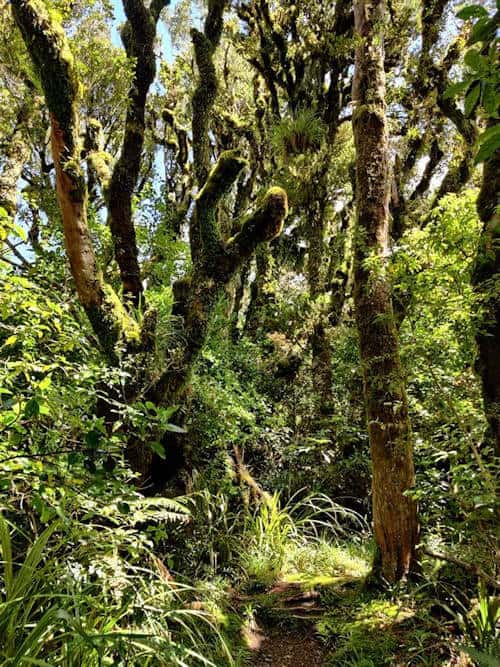Do you or your kids have a great imagination?
One place in New Zealand where it takes little to stimulate it is the “Goblin Forest”.

Located within the lush rainforest surrounding Mount Taranaki you will discover a track abundant in vegetation and holding secret twisted kamahi trunks covered with mosses and ferns.
This is the Kamahi Loop Track, a short 600m walk and suitable for all ages. 15-30 minutes return, dogs are not allowed. To reach the walk, from Stratford, follow the signs for Egmont National Park and the track begins just above the Stratford Mountain House, 15km along Pembroke Road.
The Mountain House is a step back in time, a mix of old world colonialism and stately charm. Originally planned for the Plateau the first house was constructed in 1899 by Curtis and Penn. A ramshackle building it was improved in 1900 and later turned into a two room cottage. When the exposure of the Plateau proved the location was inappropriate the building was moved to its current spot.
The twisty trees, covered with moss on this enchanted walk are a wonder of nature’s making.
When Mount Taranaki erupted approx. 400 years ago it wiped out the rimu forest around it’s base. The kāmahi tree is a common New Zealand native found from just south of Auckland all the way to Stewart Island.

The often irregular trunks and the fact the kamahi often starts as an epiphyte (an organism that grows on the surface of a plant) which has attached itself to the remains of the former rimu trunks and logs, plus its thick leathery leaves and smothering of mosses and ferns, lend to its fairytale appearance and giving that sense this could be the home of goblins, hobbits and other fairytale characters.
As well as the 600m Kamahi Loop Track, you can also take a 30 minute walk from Dawson Falls Lodge nearby which also has the Wilkies Pools at the end with their very own rock water slide!
For anyone visiting the Taranaki region a visit to this track is a must and you never know, you may just find a lost elf, or gathering of fairies!
Aotearoa is the Maori name for New Zealand, though it seems at first to have been used for the North Island only. Many meanings have been given for the name but with Maori names the true meaning can often be found only in a mythological story or in historical fiction illustrating either how the name was given or something of the ideas which prompted it. Aotearoa is made up of either two or three words, Aotea and roa or Ao tea and roa. Aotea could be the name of one of the canoes of the great migration, the great magellan cloud near the bright star Canopus in summer, a bird or even food; ao is a cloud, dawn, daytime, or world; tea white or clear, perhaps bright, while roa means long or tall.
The most popular and authoritative meaning usually given is “long white cloud”, and there are two stories current to illustrate this. It seems the voyagers to New Zealand were guided during the day by a long white cloud and at night by a long bright cloud. The more usual one tells how, when Kupe was nearing land after his long voyage, the first sign of land was the peculiar cloud hanging over it. Kupe drew attention to it and said “Surely is a point of land”. His wife, Hine-te-aparangi, called out “He ao! He ao!” (a cloud! a cloud!) Later Kupe decided to call the land after his wife's greeting to it, and the cloud which welcomed them. The name Aotea was given both to the Great Barrier and to the North Island, but the latter became Aotearoa, presumably because of its length.
According to certain authorities, the other meanings are: big glaring light (Hochstetter); continuously clear light, or land of abiding day (Stowell); long white world (Wilson); long bright world, long daylight, long lingering day, or long bright land (Cowan); and long bright day (Tregear). A good case could probably be made out for the land of abiding day, or similar names. Maui, who is closely connected with New Zealand in mythology, once snared the sun and beat him to make him travel more slowly across the sky. Perhaps Maui achieved the same end when he sailed south to fish up New Zealand where there is longer day with long twilight, particularly in the south.
'AOTEAROA', from An Encyclopaedia of New Zealand, edited by A. H. McLintock, originally published in 1966.
Te Ara - the Encyclopedia of New Zealand
URL: http://www.TeAra.govt.nz/en/1966/aotearoa (accessed 06 Jan 2021)
With domestic travel currently the only wise activity within Covid restrictions, our local tourism industry could really do with the support so Linku2 are featuring on a number of articles to help you pick what would suit you and your family to get out and enjoy our beautiful country!
100% Pure New Zealand have some great articles to give you great ideas such as their North Island Must Do Experiences including our amazing Pouakai Crossing, stunning Cathedral Cove, Rotorua's geothermal spectacles and lots more. Check these out and enjoy every single one of them! NZ.com top North Island Activities ...